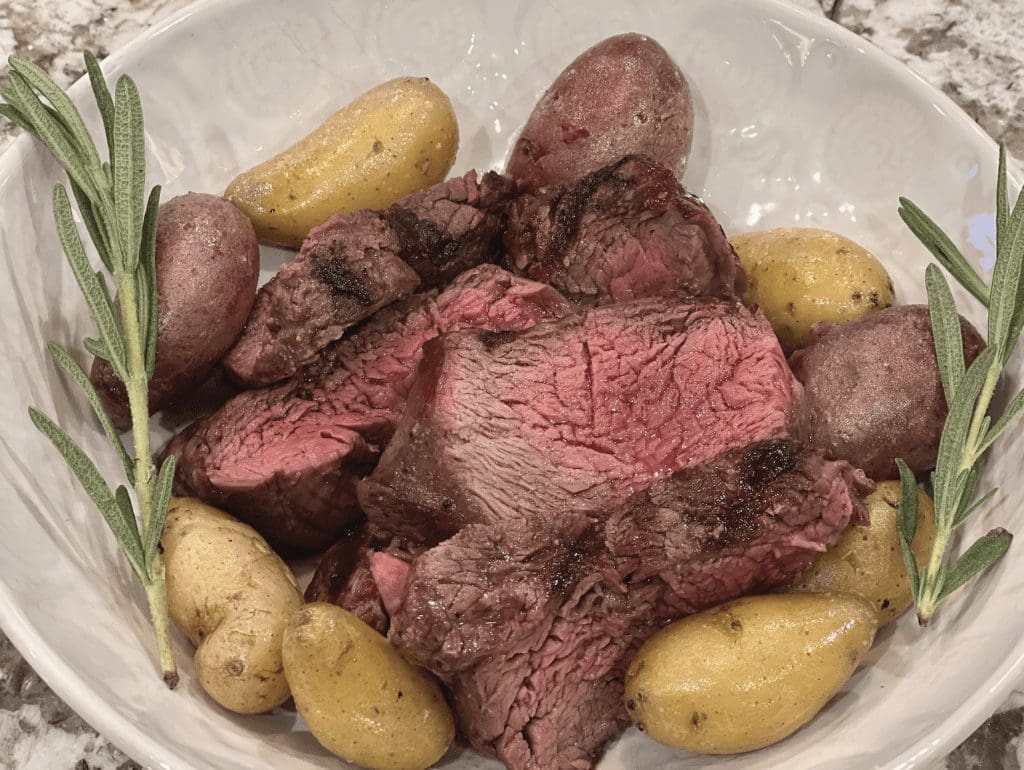MASTERING THE MODERN CHATEAUBRIAND
by James Coope
Chateaubriand is perhaps the most decadent and tender beef roast, and a traditional favorite meal for special occasions and holidays. It’s cherished for good reason! Chateaubriand is cut from the tenderloin, a highly prized cut of beef, a select cut representing 2 to 3 percent of the animal. The optimal cut is from the thick section – the filet head – but a chateaubriand can be made from any part of the tenderloin. While similar to a filet mignon, the chateaubriand is technically a roast, whereas the filet mignon is a steak.
History of Chateaubriand
Chateaubriand was named after a 19th century French aristocrat named Francois-Rene de Chateaubriand, who was said to have invented it. At the time, the cooking technique was that the tenderloin was wrapped in “lesser” meat.
It was cooked until the outer layer of meat was fully charred. The outer layer was then discarded, leaving behind an evenly cooked and tender chateaubriand. While this isn’t a common technique today, some people like to wrap the meat in bacon for extra flavor. Another characteristic of the early versions of chateaubriand was that it was cooked on an oak plank, which added a lot of flavor to the decadent cut of meat. Today, we’re not in the practice of sacrificing “lesser” meat to produce a perfect chateaubriand, and we’ve also modernized our cooking methods. Chateaubriand is an adaptable preparation as well, as you can also bake it in a pastry and voila – you have beef wellington!
Chateaubriand for One
 I wasn’t planning on hosting a party, and it certainly wasn’t a holiday or special occasion, so I skipped the full tenderloin at the butcher. (It was also incredibly expensive!) I did find a smaller cut that I could easily cook and carve for one or two people.
I wasn’t planning on hosting a party, and it certainly wasn’t a holiday or special occasion, so I skipped the full tenderloin at the butcher. (It was also incredibly expensive!) I did find a smaller cut that I could easily cook and carve for one or two people.
While chateaubriand purists may say that it should be prepared with a demi-glace, red wine or bearnaise sauce, I used a much simpler recipe with olive oil, butter and rosemary. Potatoes have always been a staple with chateaubriand, and I roasted fingerling potatoes with the chateaubriand on the skillet and served it all together.
While the grill was warming up, I seasoned the meat with olive oil, sea salt and a little bit of pepper. I prepared the potatoes separately until I combined them with the meat on my cast-iron skillet.
I used both my Traeger and Weber to cook the chateaubriand. I roasted the meat at a relatively low temperature (225 degrees) on the Traeger for about 45 minutes, until the internal temperature was about 115 to 120° F. The Traeger provides some added wood flavor from the pellets, which I suppose made an important historical link to the centuries-old practice of cooking the meat on an oak plank.
While the Traeger was doing its thing, I heated up my Weber to the hottest temperature I could get, about 600° F. Once the chateaubriand was at the right temperature (about 15° F below my desired final temperature), I transferred the chateaubriand to the Weber and “reverse-seared” each side for about 60 seconds. I’ve become a big fan of using two grills to cook steaks – I like the predictability and preciseness of the Traeger, and the power of the Weber – to produce something close to the steaks you find at fancy restaurants.
The slow roasting on the Traeger produces an evenly cooked cut, but the reverse searing helps produce a crispy (and tasty) surface on the meat itself. One thing that I learned was very important with chateaubriand is having a good thermometer you can trust!
Chateaubriand is best-served medium rare to keep it moist and tender. Paying attention to time and temperature is critical, especially with the extra step of reverse searing. After pulling the chateaubriand and the potatoes off the grill, I let it sit under foil for about 10 minutes, and then I sliced the chateaubriand to be served. The result? An incredible and tasty classic chateaubriand! It takes a little extra preparation, time and attention, but for special occasions, a chateaubriand will certainly not disappoint!






